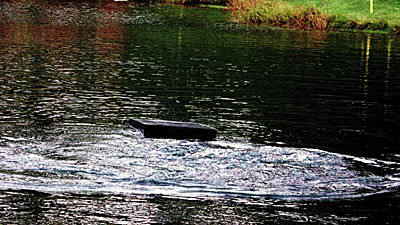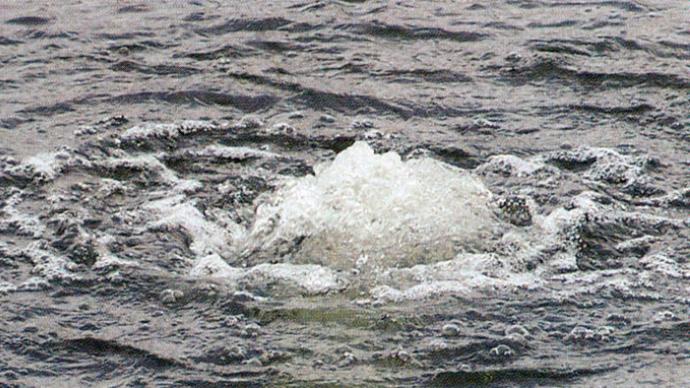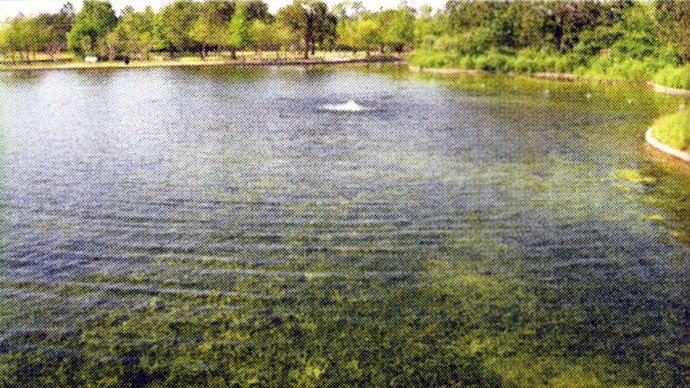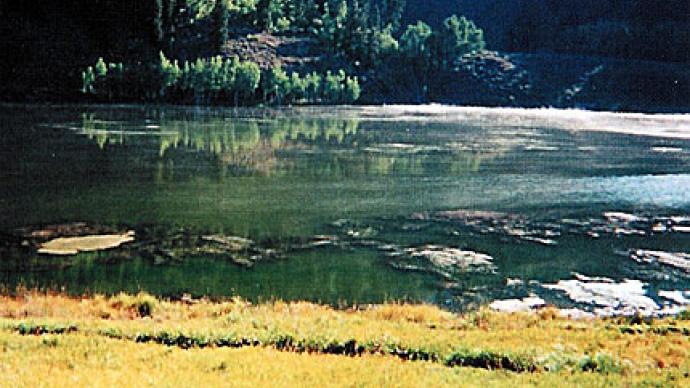
In the last issue of Pond Boss, we ran a story about a pond in the Rocky Mountains and some of the issues at higher elevations, especially when it comes to aerating shallow water. Perusing the www.pondboss.com Ask the Boss forum, looking for a topic for this issue's column, there was an interesting thread started by Chad Hullander, the mountain pond owner. He asked, "If I only wanted to aerate the top half of my water column in winter, how would I do that? I would like to turn off the bottom of the pond and eliminate or severely limit its capacity to consume dissolved oxygen. Water is 20 feet deep at the deepest. Water temperature is currently 33 degrees. Could I place diffusers in 4 feet of water and that would do it or would that cold water mix on down to the bottom anyway? Would discs have to be suspended 18" or so below the water surface? Is it even possible for me to not mix the bottom water?"
As I read these questions and the responses to follow, it struck me that the bigger topic is how to decide an aeration strategy.
I called Patrick Goodwin. Patrick is chief researcher with Vertex Water Features, based in Florida. Part of his job is to figure out the effects of aeration in ponds and lakes. He calculates oxygen demand, studies the different layers of lakes, uses bathymetry maps to compare data, all in the quest for aeration efficiency and ways to keep a dynamic system as healthy and autonomous as it can be.
For Chad's question above, Patrick dived into the physics of water. "At 39 degrees, water is most dense. For that high elevation pond, moving a diffuser shallow means affecting water at that depth and above, not necessarily merging it with deeper water." When asked if the same principle applies during summer months, he answered in the affirmative, with a few caveats. He explained that oxygen demand impacts aeration system efficiency. If aeration can keep up and get ahead of oxygen demand, the water tends to be happier. But, as with all things pond, "It depends," he said.
A fifty-year old pond in a swale between cornfields in the Midwest will be quite different than a three-year old lake in the sand hills of the Carolinas. Biological Oxygen Demand is important when deciding what system to buy, and then what strategies to use operationally.
I've told the story of the pondmeister outside Fort Worth, Texas who had a system designed specifically for his lake and liked the concept so well he bought two of them. He thought more is better. In its third year, mid-summer, his biggest, best fish started dying, one or two at a time. He started checking the temperature and oxygen content of his ten-acre lake. Temperature was taken every morning and oxygen about twice a month. From top to bottom, oxygen was where it should be, and the temperature was 87 degrees, top to bottom. His aeration system was double-efficient. But his biggest fish don't like 87-degree water and couldn't escape it. So, some of them died. Water was too hot in July in Texas. He shut off one of the systems and put the other one on a timer where it ran from 9:00 at night, until 9:00 the next morning. It took about two weeks, but the temperature dropped to 83 degrees and his fish stopped dying.
For our friend in Colorado, his biggest obstacle was winterkill, every year. His original idea of aerating had marginal impact because his natural pond has eons of organic buildup. Aerating organic matter expedites its decomposition which taxes the water. It has a high oxygen demand, even with just a few fish.
I asked Patrick what would happen if Chad raised his diffusers about up about halfway to the surface during these cold months. He said, "If he raises his diffusers, the bubble plume will impact the water column in that depth and upwards." To make sure I understood, I asked if the temperature of the water below the diffusers would be affected. He said it wouldn't. He also says that the aeration system would move enough water in its effective zone that it would likely replenish oxygen enough that some would likely diffuse into a portion of that warmer layer below. But, there's no way to know if it replenishes oxygen as fast as it might be used—that Oxygen Demand thing. Dissolved oxygen will migrate, but part of the mystery is how far that oxygen will move into that warmer lower layer.
Think of it like this. Spring is upon us. Water temperatures are beginning to rise. Nature's way is for three distinct layers to form. The one on top, the epilimnion, one in the middle, the metalimnion, and that dreaded bottom layer, the hypolimnion. The metalimnion is what we call the thermocline, which is typically a thin transitional layer like icing between layers of a cake. The thermocline is influenced by both layers sandwiching it. That top layer is thriving, and shoves a little oxygen into the thermocline. That bottom layer, which quickly loses its oxygen in late spring, early summer, is trying to suck as much oxygen as it can. The bottom of the thermocline will be anoxic most of the time.
Patrick said in winter months, moving the diffuser up in the water column will help preserve that warmer, thermal layer below. He's even measured and verified thermal refuge areas in the water directly beneath diffusers. Consider putting your diffusers on a platform to raise them off the bottom. That's a better idea than simply dragging them into shallower water—if you can figure out how to do it.
I asked about sizing an efficient aeration system and how to choose the right one. He didn't hesitate. "We start with landowner goals (sound familiar?). Then, if we can get some dissolved oxygen and temperature profiles, especially from early spring to early summer, with a bathymetry map, we can design an efficient system."
Not many people own an oxygen meter. He said, "People spend thousands of dollars to build a pond. A great oxygen meter is $1,200." I chimed in, "And if pondmeisters balk at that price, I wonder what a fish kill is worth?" Good points, both. But, since most people won't buy an oxygen meter because they can't justify it to use once a week, or twice a month, have a nearby pond management company check it for you. Records of oxygen and temperature give guys like Patrick the ammunition needed to calculate oxygen demand. Using the bathymetry map, water volume can be estimated to firm up that oxygen demand number. That value tells how much oxygen must be produced or replaced to keep the water healthy.
Aeration strategy means two things. First, strategize to pick the proper system for your pond. That's a function of engineering, based on sound data. Secondly, operational strategy can come into play, especially if you live in the hot-natured south.
During our conversation, Patrick spoke generally about all the different systems now on the market. Again, the proper system depends on pondmeister goals, the configuration of the lake, and its oxygen demand. Aerating a U-Shaped, shallow gravel quarry lake requires a different strategy than a crater-shaped, deep pond.
As we finished our conversation, Patrick threw out a carrot. "How about we collaborate on a couple of different articles about aeration, its effects, and the different systems in today's marketplace? Things in this industry are rapidly changing, even in the last year."
I'm in.
I'd love to know more about water circulators, nanobubble technology, moving water vertically and horizontally, and aerating the bottom layer without disturbing the thermocline or epilimnion.
Wouldn't you?
Reprinted with permission from Pond Boss Magazine



